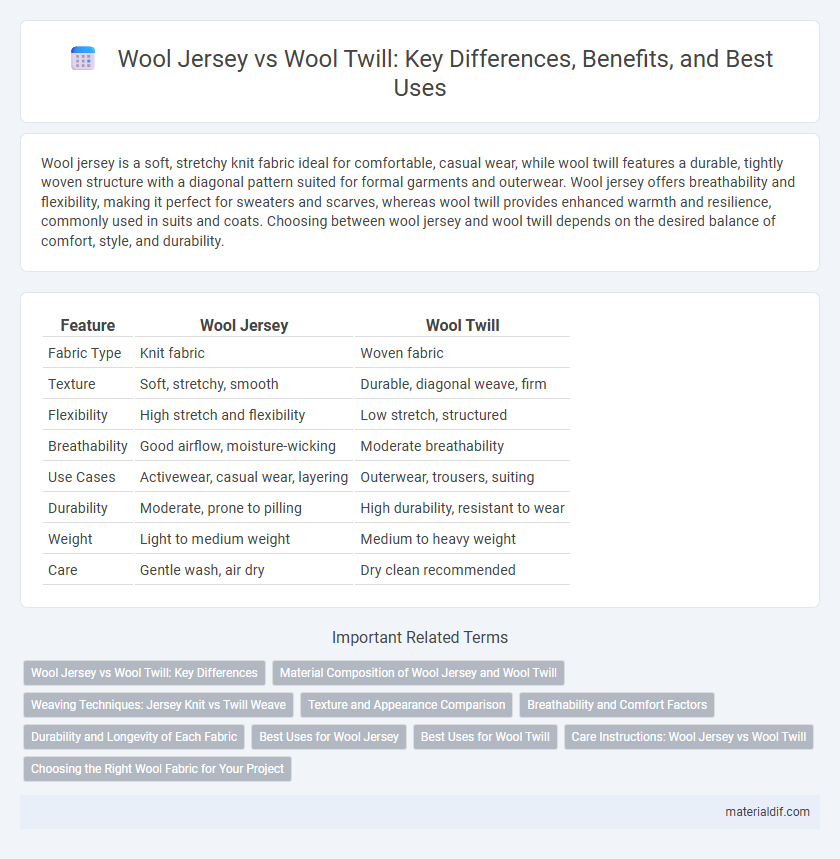Wool jersey is a soft, stretchy knit fabric ideal for comfortable, casual wear, while wool twill features a durable, tightly woven structure with a diagonal pattern suited for formal garments and outerwear. Wool jersey offers breathability and flexibility, making it perfect for sweaters and scarves, whereas wool twill provides enhanced warmth and resilience, commonly used in suits and coats. Choosing between wool jersey and wool twill depends on the desired balance of comfort, style, and durability.
Table of Comparison
| Feature | Wool Jersey | Wool Twill |
|---|---|---|
| Fabric Type | Knit fabric | Woven fabric |
| Texture | Soft, stretchy, smooth | Durable, diagonal weave, firm |
| Flexibility | High stretch and flexibility | Low stretch, structured |
| Breathability | Good airflow, moisture-wicking | Moderate breathability |
| Use Cases | Activewear, casual wear, layering | Outerwear, trousers, suiting |
| Durability | Moderate, prone to pilling | High durability, resistant to wear |
| Weight | Light to medium weight | Medium to heavy weight |
| Care | Gentle wash, air dry | Dry clean recommended |
Wool Jersey vs Wool Twill: Key Differences
Wool Jersey features a soft, stretchy knit texture ideal for comfortable, form-fitting garments, while Wool Twill is a woven fabric characterized by its diagonal rib pattern, providing durability and structure. Wool Jersey excels in flexibility and breathability, making it suitable for casual wear, whereas Wool Twill offers superior wrinkle resistance and a polished appearance perfect for tailored suits. The fiber alignment in Wool Twill results in increased strength, contrasting with the relaxed fit and lightweight nature of Wool Jersey.
Material Composition of Wool Jersey and Wool Twill
Wool Jersey is typically composed of fine, soft wool fibers knitted to create a flexible, breathable fabric often blending merino wool for enhanced softness and moisture-wicking properties. Wool Twill, on the other hand, consists of tightly woven wool fibers arranged in a distinct diagonal weave pattern, providing durability and a structured texture ideal for suiting and outerwear. Both materials leverage wool's natural insulating qualities but differ significantly in fiber arrangement and fabric weight, influencing their respective uses and comfort levels.
Weaving Techniques: Jersey Knit vs Twill Weave
Wool Jersey is produced using a jersey knit technique, which creates a stretchy, lightweight fabric with a smooth surface and excellent breathability, making it ideal for comfortable, form-fitting garments. Wool Twill employs a twill weave, characterized by diagonal parallel ribs that enhance durability, texture, and drape, making it suitable for structured outerwear and tailored pieces. The distinct knitting of wool jersey versus the woven pattern of wool twill fundamentally influences the fabric's flexibility, appearance, and use in fashion.
Texture and Appearance Comparison
Wool Jersey features a smooth, stretchy texture with a fine, knit appearance, making it ideal for comfortable, form-fitting garments. Wool Twill displays a distinct diagonal weave pattern, giving it a more structured and textured surface with a slightly heavier feel. The contrast in texture between the soft, flexible Wool Jersey and the firm, textured Wool Twill influences their suitability for different apparel styles.
Breathability and Comfort Factors
Wool jersey offers superior breathability due to its knit construction, allowing better air circulation and moisture management, which enhances overall comfort in varying temperatures. Wool twill, characterized by its tight weave, provides a denser fabric that offers durability but tends to retain more heat, making it less breathable than wool jersey. For comfort-focused garments requiring flexibility and ventilation, wool jersey is often preferred, while wool twill suits applications where structure and resilience are prioritized.
Durability and Longevity of Each Fabric
Wool twill features a diagonal weave that enhances its durability and resistance to wear, making it ideal for long-lasting garments exposed to frequent use. Wool jersey, known for its stretch and softness, offers moderate durability but is more prone to pilling and stretching over time compared to wool twill. Longevity in wool twill typically surpasses that of wool jersey due to its tighter weave and sturdier structure, ensuring extended lifespan in heavy-duty or tailored clothing.
Best Uses for Wool Jersey
Wool jersey offers a soft, stretchy texture ideal for garments requiring comfort and flexibility, such as sweaters, t-shirts, and casual dresses. Its breathable, lightweight nature makes it perfect for layering in cool-weather clothing without adding bulk. Wool twill, by contrast, is more structured and durable, better suited for tailored coats and trousers where rigidity and resilience are essential.
Best Uses for Wool Twill
Wool twill is best used for tailored garments such as suits, blazers, and trousers because of its distinctive diagonal weave that provides durability and a smooth drape. Its sturdy texture makes it ideal for outerwear and workwear, offering resistance to wrinkles and a structured look that holds shape well. Wool twill's moisture-wicking properties and breathability also make it suitable for active and formal wear in varied climates.
Care Instructions: Wool Jersey vs Wool Twill
Wool Jersey requires gentle hand washing or dry cleaning to maintain its soft, stretchy texture, avoiding high heat that can cause shrinkage. Wool Twill demands careful dry cleaning or cold water washing with mild detergent to preserve its dense weave and durability. Both fabrics should be laid flat to dry, and ironing wool requires a low heat setting with a pressing cloth to prevent damage.
Choosing the Right Wool Fabric for Your Project
Wool jersey offers a stretchy, soft texture ideal for comfortable garments and activewear, while wool twill presents a durable, tightly woven fabric best suited for structured pieces like trousers and jackets. Consider wool jersey if your project demands flexibility and breathability, and opt for wool twill when strength and a polished appearance are priorities. Evaluating the specific requirements of your design will ensure the wool fabric chosen enhances both functionality and style.
Wool Jersey vs Wool Twill Infographic

 materialdif.com
materialdif.com